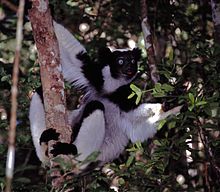Indri
| Indri | ||||||||||||
|---|---|---|---|---|---|---|---|---|---|---|---|---|

Indri ( Indri indri ) |
||||||||||||
| Systematics | ||||||||||||
|
||||||||||||
| Scientific name of the genus | ||||||||||||
| Indri | ||||||||||||
| É. Geoffroy Saint-Hilaire & G. Cuvier , 1796 | ||||||||||||
| Scientific name of the species | ||||||||||||
| Indri indri | ||||||||||||
| ( Gmelin , 1788) |
The indri ( Indri indri ) is a primate of the family of Indriartigen (Indriidae). It is the largest recent lemur and lives in northeastern Madagascar .
description
Indris reach a head-trunk length of 64 to 90 centimeters, the tail is only a stub 4 to 5 centimeters in length - they are the only stump-tailed lemurs. Their weight is 6.5 to 9.5 kilograms. The hind legs are longer than the front legs, the first toe is large and opposable . Their fur is very dense and patterned white-gray-black, although the coat pattern can vary. Animals in the south are more whitish, while animals in the north of the range are more black. The head, ears, and back are usually black in all Indris. The face is characterized by the large, bushy ears and the small, almost hairless muzzle.
distribution and habitat
Like all lemurs, Indris live only in Madagascar. The distribution area includes the northeastern parts of the island. Their habitat are the tropical rainforests , they occur up to 1800 meters above sea level, but prefer regions below 1000 meters.
Lifestyle and diet
Indris are tree dwellers who only occasionally come to the ground. In the branches they move with their strong hind legs, climbing and jumping vertically. On the ground, the Indri, like all species of the Indris family, moves with its hind legs hopping, with its short arms stretching upwards. Indris are the most diurnal of all lemurs and only move at night in very bad weather or when attacked by a predator. You can often see them sunbathing in the trees, spreading out on forks of branches.
They live together in small groups of two to five animals, usually a monogamous couple with their offspring. The female is dominant and has preference in food sources. As a rule, they only look for a new one after the partner's death. They inhabit a solid area of around 17 to 40 hectares, which the males mark with scent glands. The daily roaming areas are around 770 meters long. Typical of the Indris are the loud morning chants to mark or defend their territory. These chants, which are usually heard between 7:00 and 11:00 a.m., are performed by both partners in a duet and can be heard 2 kilometers away. Indris feed mainly on leaves, to a lesser extent they also eat fruits and flowers. They sometimes come to the ground to eat soil, presumably this helps break down the toxins present in the leaves. Like many other leaf-eating mammals, they compensate for the low nutritional value of their food by taking long breaks.
Reproduction
Every two to three years the female gives birth to a single young after a gestation period of four to five months. The boy clings first to the mother's stomach and later to her back. It is weaned at around six months. At around eight months it is self-employed, but stays with the family for over a year. Females only become sexually mature when they are seven to nine years old. Nothing is known about life expectancy.
Indris and people
The word 'Indri' means “there it goes” - a misunderstanding between the French naturalist Pierre Sonnerat and the Malagasy population (disputed), in whose language the animal is called Babakoto. The conjugal fidelity, the song-like screaming and the sunbathing behavior have led to all kinds of superstitions. According to the Madagascans, this is how the animals worship the sun. The souls of the dead should also live on in the animals. This view completely protected the Indris from hunting until recently.
The destruction of the habitat is the main threat to the Indris today. Furthermore, it cannot be kept in human care, so that breeding programs are impossible. In protected areas, however, survival of the species appears to be assured to a small extent. Nevertheless, the IUCN lists the Indri as critically endangered (CR).
The species is no longer kept in Europe, the former owner was the Ménagerie du Jardin des Plantes in Paris.
literature
- Thomas Geissmann : Comparative Primatology. Springer-Verlag, Berlin a. a. 2002, ISBN 3-540-43645-6 .
- Nick Garbutt: Mammals of Madagascar. A Complete Guide. Yale University Press, New Haven CT et al. a. 2007, ISBN 978-0-300-12550-4 .
- Ronald M. Nowak: Walker's Mammals of the World. 6th edition. Johns Hopkins University Press, Baltimore MD 1999, ISBN 0-8018-5789-9 .
supporting documents
- ↑ Willard Van Orman Quine: The roots of reference (= Suhrkamp pocket book science . Volume 764 ). Suhrkamp, Frankfurt 1976. Here: §11 (learning by reference), p. 71.
- ^ Encyclopedia Britannica, 11th edition, p. 501, entry Indri
- ^ Ian Hacking : Was there ever a radical mistranslation? In: Analysis . tape 41 , no. 4 , October 1981, p. 171-175 , JSTOR : 3327741 .
- ↑ Indri data sheet on Zootierliste.de, accessed on December 31, 2015.
Web links
- Indri indri onthe IUCN Red List of Threatened Species . Retrieved April 21, 2009.

